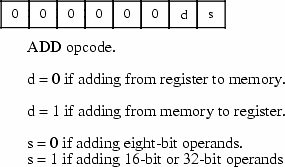-
Bit number zero marked s specifies the size of the operands the ADD instruction operates upon:
-
If s = 0 then the operands are 8-bit registers and memory locations.
-
If s = 1 then the operands are either 16-bits or 32-bits:
-
Under 32-bit operating systems the default is 32-bit operands if s = 1.
-
To specify a 16-bit operand (under Windows or Linux) you must insert a special operand-size prefix byte in front of the instruction (example of this later.)
-
-
-
_________________________
-
You'll soon see that this direction bit d creates a problem that results in one instruction have two different possible opcodes.
-
x86 ADD instruction opcode :

-
Bit number one, marked d, specifies the direction of the data transfer:
-
If d = 0 then the destination operand is a memory location, e.g.
add [ebx], al
-
If d = 1 then the destination operand is a register, e.g.
add al, [ebx]
-